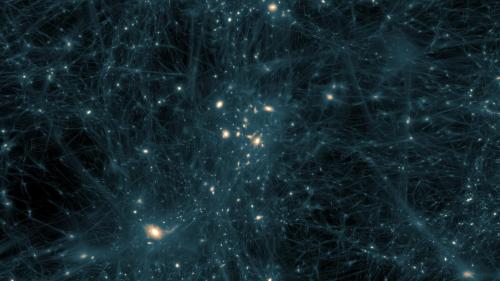Dark Matter 3: Filaments - The largest structures in the universe In my last blog post, I talked abo
Dark Matter 3: Filaments - The largest structures in the universe In my last blog post, I talked about how dark matter or something similar must exist in galaxies, as they seem to be rotating far too quickly to match Newton’s laws. If this dark stuff does exist, then it must be dominant towards the outside of the galaxies, forming a ‘halo’ structure, which would explain why all the stars and gas we see here seem to travel at very fast speeds. However, we are yet to find a dark matter particle, so in order to make dark matter seem like a more realistic theory, we need to find another use for it in the Universe. The force of gravity is more difficult to see on a small scale so we are unlikely to see its influence here on Earth. So the solution is clear, we need to look at bigger structures in the Universe! Well what’s bigger than a galaxy? What can be bigger than the largest collection of stars in the universe? It turns out that we can get groups of galaxies called clusters and even bigger ones called superstructures. This makes sense; if groups of stars can attract one another enough to form a galaxy, then galaxies can attract one another to form a cluster. This is shown in the first image, which shows a plot of galaxies as we can see from Earth. There are clear groups of galaxies visible in all directions, along with voids (which may provide evidence for dark energy - maybe I’ll make a blog series about this one day!). However, if we zoom out even further and look at even more distant galaxies (millions of light years away), we find something really quite surprising. These superclusters all seem to line up and form filaments - this is shown in the second image. It almost acts like a 'cosmic web’ with gas clouds and galaxies all connected via the force of gravity. This is surprising because if we look at images like the CMBR, the universe looks like it should be roughly the same in all directions. So the force gravity must be strong enough that it can pull all these galaxies together to form a very clear pattern. Its unsurprising then to find that these filaments line up with tendrils of dark matter, as predicted by simulations that calculated how the Universe formed, and how it changes over time. So dark matter exists on both galactic scales, and also in extra-galactic scales, showing its influence through the force of gravity. It seems to line up and stick to 'ordinary matter’, causing it to form recognisable patterns in the universe. Now we know what dark matter actually does in the universe, we can now start to look at what it might be made of. Is it just so far undiscovered particle? Or could it be something bigger that we just can’t see? More in the next post! -- source link
Tumblr Blog : rotationcurve-blog.tumblr.com
#astrophysics#dark matter#universe#science#physics#astronomy

